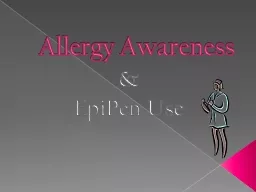

Common allergies in children Tree Nuts Milk Egg Peanut Bananas Pollen Soy Shellfish Latex Fish Wheat Animal Dander What is an allergy An allergy is an abnormal response to a normal substance ID: 690271
Download Presentation The PPT/PDF document "Allergy Awareness & EpiPen Use" is the property of its rightful owner. Permission is granted to download and print the materials on this web site for personal, non-commercial use only, and to display it on your personal computer provided you do not modify the materials and that you retain all copyright notices contained in the materials. By downloading content from our website, you accept the terms of this agreement.
Slide1
Allergy Awareness
&EpiPen UseSlide2
Common allergies in children:
Tree NutsMilk
Egg
Peanut
BananasPollen
SoyShellfishLatexFishWheatAnimal DanderSlide3
What is an allergy?
An allergy is an abnormal response to a normal substance. This is the body’s attempt to defend itself against substances that are perceived by the body to be harmful (an allergen).
There are various degrees of reaction. Symptoms can occur up to 72 hours or more after exposure to the allergen and can last for several days. Symptoms may or may not be life-threatening.
Allergic reactions can be caused by certain
foods,
medications, bee stings and products such as latex.Slide4
What is anaphylaxis?
Anaphylaxis is the life-threatening form of an allergic reaction.Anaphylaxis is defined as a sudden, severe allergic response that usually produces breathing difficulties, collapse and possible death.Anaphylaxis usually occurs 1-15 minutes after exposure, rarely after 2 hours.
Anaphylaxis requires
immediate action-EpiPen administration.Slide5
Allergic Reactions VS Anaphylactic Reactions
Allergic ReactionsRunny noseItchy, red, watery eyes
Local reaction to sting, UNLESS known to be allergic to venom
Anaphylactic Reactions
HivesSwelling (face, lips, tongue, throat, upper airway)
Difficulty breathing Cramping, vomiting, diarrheaDifficulty swallowing Weakness, paleness, sweatingFeeling of impending doomSlide6
Flow ChartSlide7
EpiPen Instructions
EpiPens are easy to use.Remember, you must hold the EpiPen in place for 10 seconds. The individual may feel a painful, burning sensation while the medication is being administered.
Training is available through the school nurse.
You are covered by the Good Samaritan Law.Slide8
.Slide9Slide10
Emergency Action Plan
Be aware of the students that have life-threatening allergies in your classroom and what they are allergic to.TAKE ALL REACTIONS SERIOUSLY !
Administer EpiPen if you recognize a student’s reaction as anaphylactic, or call a trained staff member to immediately assist with the administration of EpiPen.
Call 911.
Monitor the student’s breathing and circulation, perform CPR when necessary.Notify the parent/guardian.The “Good Samaritan Law” protects all individuals who administer an EpiPen from liability issues.Slide11
Teacher’s Checklist
Be familiar with your school’s emergency procedures. Know how to recognize the symptoms of an allergic reaction and what to do if a reaction occurs.Be sure to notify substitute teachers and aides about students’ food allergies.Avoid using food in your lesson plans, such as math lessons and art projects.Don’t use food as an incentive or reward.
Minimize the use of food in class parties or celebrations.
Develop a plan for communicating with parents about issues that might affect their child’s food allergies.
Consider food allergies when planning for field trips, and be sure to include the school nurse and parents early in the planning process.Check the ingredient labels on pet food, if your classroom has a pet.From Food Allergy and Anaphylaxis networkSlide12
Virginia School Health Guidelines: Responding to Anaphylaxis
Recognize Symptoms of Anaphylasis a life-threatening reaction. Obtain the epi
-pen.
If you are alone and do not know how to provide epinephrine, call out or yell for help. If someone is available to help you, have them get the personnel trained to provide epinephrine and the epinephrine while you dial 911and follow the dispatcher’s instructions. Advise 911 operator that anaphylaxis is suspected and epinephrine is available. Your goal is to get someone (EMS or trained personnel) to provide epinephrine and care as soon as possible. Slide13
Virginia Guidelines: Responding to anaphylaxis cont.
Select appropriate epinephrine auto-injector to administer, based on weight. Dosage: 0.15 mg Epinephrine auto-injector IM, if less than 66 pounds 0.30 mg Epinephrine auto-injector IM, if 66 pounds or greater
Frequency: If symptoms persist or return, a second dose should be administered 5 to 15 minutes after first dose
Inject epinephrine via auto-injector: Pull off safety release cap. Swing and jab firmly into upper, outer thigh, (through clothing if necessary).
Hold in place for 10 seconds to deliver medication and then remove. Massage the area for 10 more seconds. Note the time. Slide14
Virginia Guidelines: Responding to anaphylaxis cont.
Call or have a bystander call 911 immediately or activate the Emergency Medical System (EMS). Advise 911 operator that anaphylaxis is suspected and epinephrine was given.
Keep the individual either lying down or seated. If they lose consciousness, check if they are breathing and have a pulse. If not, begin CPR (cardiopulmonary resuscitation), call out for help and continue CPR until the individual regains a pulse and is breathing or until EMS arrives and takes over.
Call School Nurse/Front Office school personnel and advise of situation.
Repeat the dose after 5 to 15 minutes if symptoms persist. Stay with the individual until EMS arrives, continuing to follow the directions in No. 5 above.
Provide EMS with Epinephrine auto injector labeled with name, date, and time administered to transport to the ER with the student. Slide15
Follow-up
1. Assure parents/guardians have been notified and advised to promptly let the student’s primary care physician know about the episode of suspected anaphylaxis. 2. Complete required documentation of incident. Slide16
Go to site below to take quiz and submit completion
After completing quiz, See the school nurse to complete competency checklists
Allergy/Anaphylaxis/
Epi
Confirmation SurveySlide17
Resources
Epi-Pen, (2012). Available at http://www.epipen.com. Food Allergy and Anaphylaxis Network. (2012). Available at www.foodallergy.orgVirginia Department of Education, (2012). Guidelines for
Recognition and Treatment of Anaphylaxis in the School Setting
. Retrieved July 24, 2012, from http://www.doe.virginia.gov/support/health_medical/anaphylaxis_epinephrine